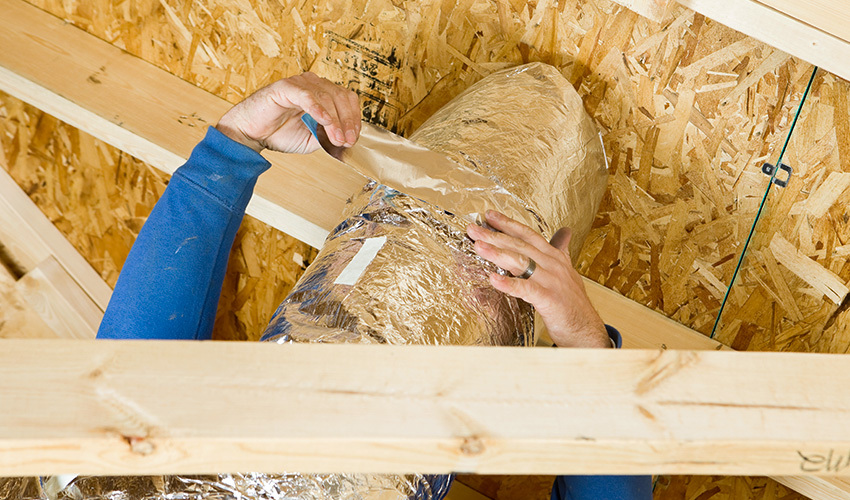How to Insulate Ductwork | Air Duct Insulation

Was your energy bill higher than you expected last year? It might be time to check your heating and cooling system. The ductwork that connects the heating, ventilation, and cooling (HVAC) systems in your home may be an important source of energy waste in your home.
Why Insulate Your Ductwork?
Ductwork is usually made of metal or fiberglass. Ducts carry hot or cold air through the walls and ceilings of your home. Sometimes ducts are installed in drafty spaces without climate control, like your attic. If your ducts are poorly sealed or uninsulated, you may be losing heated or cooled air into these spaces.
Insulating your ductwork will save you money on your energy bill and also reduce strain on your furnace during the winter.
With some simple tools and techniques, homeowners can insulate their ductwork in the space of an afternoon.
Ductwork Insulation Supplies
- Thermal insulation
- Duct mastic (duct sealant)
- Foil tape
- Carpenter’s square
- Utility knife
- Goggles
- Dust mask
How to Choose Insulation
Your choice of insulation depends on the climate you live in. The colder the climate, the more insulating a material you should choose.
All insulations are assigned what’s called an R-value. The R-value is a measure of the resistance to air and temperature flow a material provides. You should usually choose insulation with an R-value of 6 or higher.
How to Insulate HVAC Ductwork
- Check your ductwork for any leaks. Look for tears, feel for air coming from joints in the duct or use a smoke pencil or incense to sense for small air leaks.
- Seal any cracks, gaps, or other leaks with the mastic.
- Check the condition of the preexisting insulation. If it’s in decent condition, you can apply the new layer of insulation around it. If it’s in poor condition, remove it.
- Using the carpenter’s square and utility blade, cut the insulation to the right length and width. Make sure it won’t compress the fiberglass too much when installed.
- Attach insulation at the seams using small pieces of foil tape to keep everything in place.
- Seal all the seams and exposed ends of insulation with long pieces of foil tape.
- Make sure all seams are tightly sealed to avoid condensation settling under the insulation.
Now that you’ve insulated your ductwork, consider other things that could affect the air quality in your home. Always make sure you have a properly installed carbon monoxide detector. Be sure to schedule routine air duct cleaning with your local Aire Serv.
Breathe Easy with Duct Work from Aire Serv
Aire Serv® inspects whole HVAC systems, cleans air ducts, and can recommend the right air duct insulation for your climate and home. Request an appointment online or call (855) 679-0011 and breathe a little easier knowing your air ducts will be cared for.
 Click to call
Click to call


